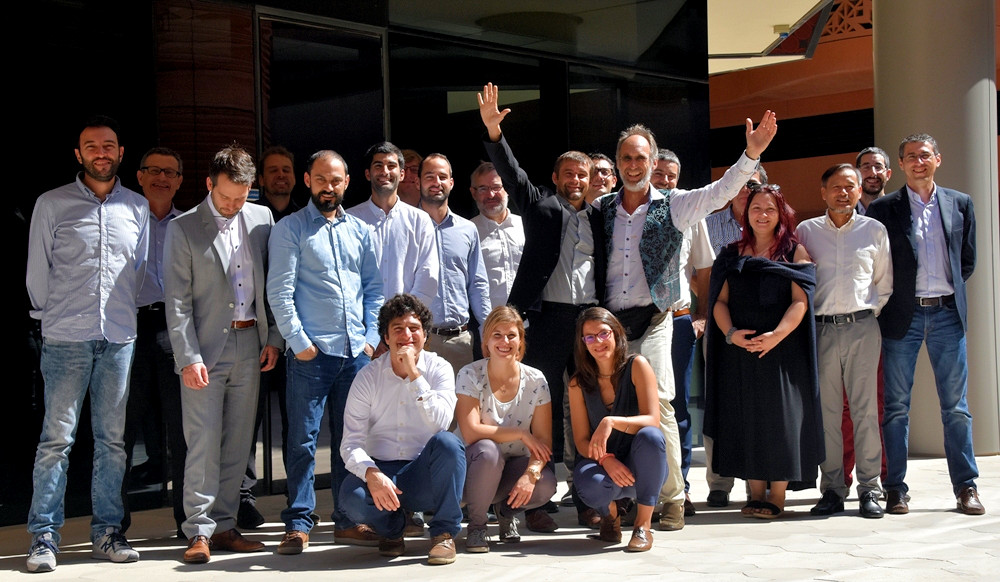Posted: February 10, 2018

Source: Task 53
Despite Australia’s high levels of solar irradiation and rising energy costs, its solar heating and cooling market has been in decline each year since 2010. The newly installed glazed and unglazed collector area went from a peak of 1.14 million m2 in 2009 to 544,670 m2 in 2016 – less than half of what it used to be. Reversing the downward spiral is the aim of an industry roadmap, titled Solar Heating and Cooling in Australia´s Built Environment, which was commissioned by ARENA, the Australian Renewable Energy Agency, and is currently under review. During an internal workshop in Abu Dhabi last November, Australian-based consultancy Coolgaia discussed the findings from the roadmap with solar cooling experts working on Task 53 of the IEA Solar Heating and Cooling Programme (see photo).
Heating and cooling demand on the up
The roadmap outlines the unique situation of Australia’s built environment, which has led to a constant increase in heating and cooling demand:
- Since 2000, Australia´s population has grown between 1 and 2 % annually.
- During the same period, the increase in GDP has been mostly above 2 % per year.
- The number of households rose from 6.06 million in 1990 to 9.4 million in 2017 (plus 55 %).
- Growth is expected to continue.
| Energy consumption |
2008/2009
|
2017
|
2020
|
Growth
2017 to 2020
|
|
Residential
|
402 PJ
|
441 PJ
|
467 PJ
|
6 %
|
|
Commercial
|
135 PJ
|
159 PJ
|
170 PJ
|
7 %
|
Rising energy consumption in Australia: past – current – future
Source: Coolgaia
State of the SHC market
The solar heating and cooling data paints a rather grim picture of the market:
- According to the Clean Energy Council, 2016 saw the installation of only 49,553 residential solar water heaters, a reduction by almost one-fourth compared to the 194,695 systems in the peak year of 2009.
- The Clean Energy Regulator, CER, expects the number of small-scale technology certificates, or STCs, for commercial solar hot water systems to drop from 131,000 in 2016 to 34,000 in 2019. STCs are purchased by electricity retailers and submitted to CER to meet the retailer´s legal obligations under the Renewable Energy Target scheme.
- Australia has less than 20 solar cooling installations in operation; with very few exceptions, these systems are in the R&D or proof-of-concept stage.
Barrier analysis
The attached paper lists several barriers responsible for the negative trend on the market:
- Politically divisive situation
- Small market with limited local capacity for complex SHC component production
- Inexperienced and untrained consultants and trade professionals
- Lack of awareness of benefits and unrealistic expectations
- Advancements from cost-effective PV solutions and high-efficiency heat pumps
Three-pillar approach
“With this roadmap, we look at the current environment and suggest measures that we can implement realistically now and not in the long-term future,” Marc Sheldon, Managing Director of Coolgaia, explained during the Task 53 workshop. The roadmap’s authors recommend a three-pronged approach (see the following table).
|
Develop & Implement
|
Support
|
Inform
|
|
Standardisation / best-practice design – extend AS5389
|
- Environmental upgrade agreements (EUAs)
- on-bill finance
- energy performance contracts (EPCs) / energy service companies (ESCOs)
|
- Training / knowledge dissemination
|
The support measures focus on facilitating access to financing, rather than calling for direct subsidies, which are difficult to enforce politically. Environmental upgrade agreements, or EUAs, for example, should be in use all around the country. These EUAs, which consist of contractual agreements with a local council and a finance provider, allow building owners to obtain capital at a rate that is lower over the longer term than the one on a conventional bank loan. Under an EUA, the finance provider agrees to advance capital to the building owner for funding environmental upgrades to a building, capital that will be repaid via council rates. According to the roadmap’s authors, on-bill finance should be extended to include the standard demand-management practices of all electric utilities. In this case, the utility prefinances energy efficiency upgrades and receives monthly payments equal to or less than the energy saved by the building owner.
The roadmap is part of PUSCH, a project Promoting Use of Solar Cooling and Heating in Australia, which is being implemented and financed by ARENA, Coolgaia, CSIRO – Commonwealth Scientific and Industrial Research Organisation and AIRAH – Australian Institute of Refrigeration, Air conditioning and Heating. The roadmap is said to be published in the course of the first quarter of this year.
The international research cooperation Task 53, titled New Generation Solar Cooling and Heating Systems (2014 to 2018), has brought together researchers from 10 countries. The final task meeting is scheduled to take place in mid-April in Dresden, Germany.
Organisations and projects mentioned in this article: